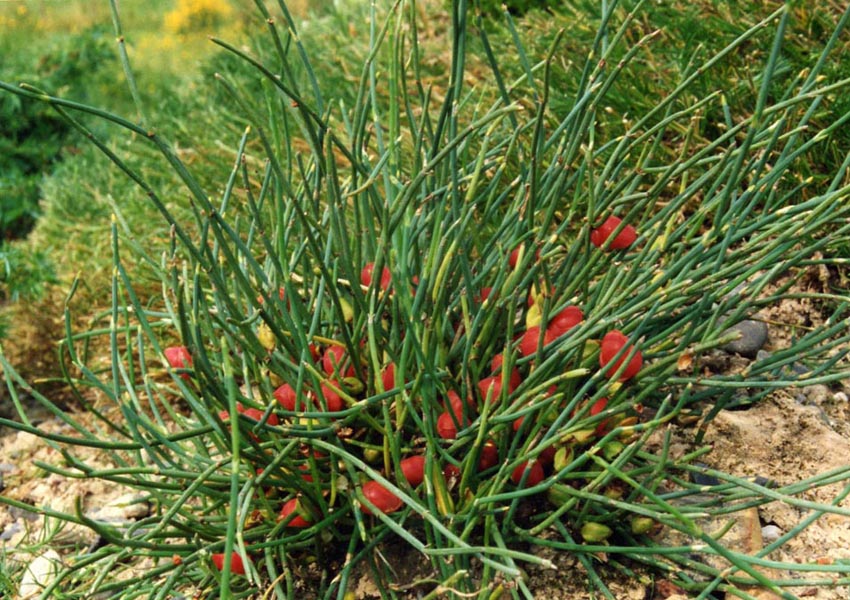

| Biological Name: Ephedra sinica, Ephedra intermedia, Ephedra equisetina, Ephedra distacha, Ephedra trifurca |
| Other Names: Mahuang, Ma Huang, desert tea, Mormon tea, American ephedra, Chinese ephedra, European ephedra, Pakistani ephedra, Ephedra |
| Parts Used: |
| Active Compounds: Ephedra’s active medicinal ingredients are the alkaloids ephedrine and pseudoephedrine. The stem contains 1-3% total alkaloids, with ephedrine accounting for 30-90% of this total, depending on the plant species employed. Both ephedrine and its synthetic counterparts stimulate the central nervous system, dilate the bronchial tubes, elevate blood pressure, and increase heart rate. Pseudoephedrine (the synthetic form) is a popular over-the-counter remedy for relief of nasal congestion. |
| History:The Chinese have used ephedra medicinally for over 5,000 years. Ephedra is listed as one of the original 365 herbs from the classical first century A.D. text on Chinese herbalism by Shen Nong. Ephedra’s traditional medicinal uses include the alleviation of sweating, lung and bronchial constriction, and water retention. Coughing, shortness of breath, the common cold, and fevers without sweat are all indications for its use. While the active constituent, ephedrine, was isolated in 1887, it was not until 1924 that the herb became popular with physicians in the US. for its broncho-dilating and decongesting properties. |
| Remedies For: Diaphoretic, bronchial dilator, diuretic
Induces perspiration, warms coldness, relieves wheezing, moves fluids. It is used for common cold, wheezing, bronchial asthma, bronchitis, and edema. Useful for:
Ephedra is used to treat asthma, hay fever, the common cold, and as a weight loss aid. Asthma and hay fever: Ephedra is useful in the treatment of mild to moderate hay fever and asthma. It is recommended that you supplement the ephedra use with substances that support the adrenal glands, such as licorice, panax ginseng, vitamin C, magnesium, zinc, vitamin B-6, and pantothenic acid. Weight Loss Aid: Ephedrine suppresses the appetite and increases the metabolic rate of adipose tissue. Ephedrine activates the sympathetic nervous system, increasing the metabolic rate and increasing the amount of the food converted to heat (thermogenesis). This prevents the body from converting these foods to fat, thus helping in the control of weight gain by those who have low metabolism. Ephedrine is often used in conjunction with methylxanthine sources such as coffee, tea, cola nut, and guarana. The methylxanthines enhances the thermogenic effect of ephedrine. Clinical studies have also shown that aspirin may be effective in increasing the thermogenic effect of ephedrine. |
| Description:Ephedra is a shrublike plant found in desert regions throughout the world. It is distributed from northern China to Inner Mongolia. The dried green stems of the three Asian species (E. sinica, intermedia, equisetina) are the plant parts employed medicinally. The North American species of ephedra does not appear to contain the active ingredients of its Asian counterparts. The plants are 1.5 to 4 foot high. They typically grow on dry, rocky, or sandy slopes. The many slender, yellow green branches of ephedra have two very small leaf scales at each node. The mature, double seeded cones are visible in the fall. |
| Dosage: The crude powdered stems of ephedra (with less than 1% ephedrine) are employed at a dose of 1-4 grams per day in tea form.
Tinctures of 1-4 ml three times per day can be taken. Over-the-counter drugs containing ephedrine can be safely used by adults at a dose of 12.5-25 mg every four hours. Adults should take no more than 150 mg every twenty-four hours. Pseudoephedrine is typically recommended at a dose of 60 mg every six hours. |
| Safety:Ephedra should not be used by those with external deficiency with symptoms of spontaneous sweating. Because the alkaloids have an effect similar to that of adrenaline, ephedra should not be used with symptoms of high blood pressure or insomnia.
Ephedra has a long history of safe use at the recommended amount. However, abuse of the drug-especially for weight loss-can lead to amphetamine-like side effects, including elevated blood pressure, muscle disturbances, insomnia, dry mouth, heart palpitations, nervousness, and even death due to heart failure. Anyone with high blood pressure, heart conditions, diabetes, glaucoma, thyroid disease, and those taking MAO-inhibiting antidepressants should consult with a physician before using any type of product with ephedra. Pseudoephedrine can cause drowsiness and should be used with caution if driving or operating machinery Ephedra-based products should be avoided during pregnancy and lactation and used with caution in children under the age of six years. US FDA recommends that the amount of ephedra added to dietary supplements to 8 milligrams. FDA wants warning labels put on the products cautioning against taking them for more than a week, and advising consumers not to combine them with other stimulants. These were retracted on strong opposition from the General Accounting Office (GAO), that the agency does not have enough evidence to make such recommendation. However, FDA has kept the warning against mixing ephedrine with other stimulants. Medical experts suggest that used as a stimulant, ephedra can raise blood pressure and heart rate, cause vomiting, heart palpitations, dizziness, nervousness and more serious reactions, including heart attacks, seizures and strokes. U.S. FDA has said that between 1997 and 1999 it had received 140 reports of illness or death linked to ephedra alkaloids. Since then, the agency has gotten another 103 such reports, but those haven’t been investigated. A recent study reported in the New England Journal of Medicine suggest that ephedra might be the main culprit for those deaths. (Read the entire article on the discussion of the safety of this drug.) Because of the possible danger due to the abuse, we recommend that you should limit the amount of this herb consumed strictly. It has been shown that many times, the actual amount of the active ingredients present in the products can differ substantially from batch to batch due to poor quality controls. So, caution is recommended. We also recommend that you do not take this with stimulants such as caffeine. |
Related Topics:
|
